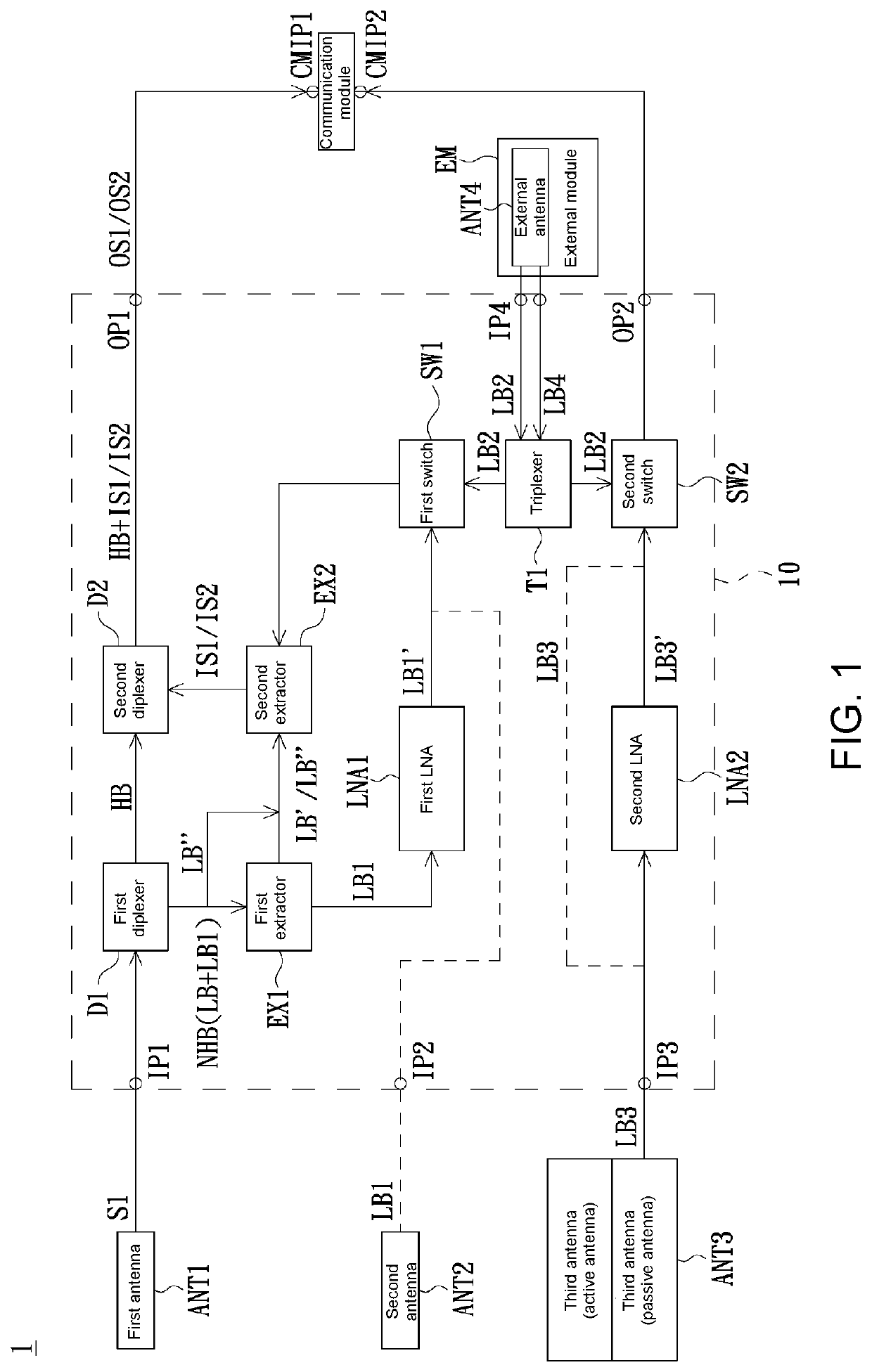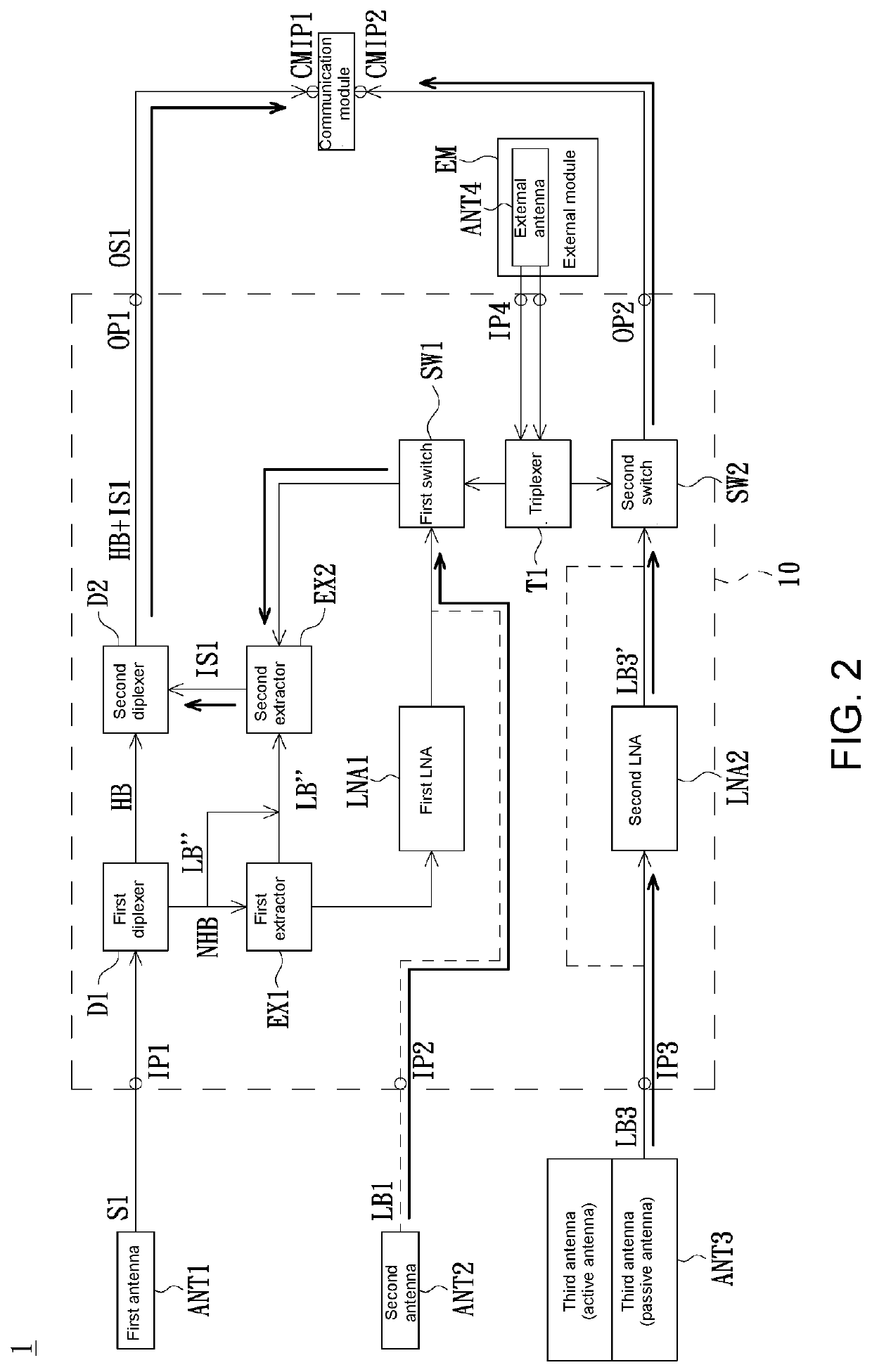Signal integration circuit and electronic device
- Summary
- Abstract
- Description
- Claims
- Application Information
AI Technical Summary
Benefits of technology
Problems solved by technology
Method used
Image
Examples
first embodiment
[0027]Refer to FIG. 2 to FIG. 5 showing schematic diagrams of signal paths according to four embodiments of the present invention. In the first embodiment, as shown in FIG. 2, the first L1 band signal LB1 is inputted via the second antenna ANT2, and can be directly transmitted into the first switch SW1 without an LNA since the second antenna ANT2 is an active antenna. After the first L1 band signal LB1 passes through the first switch SW1, the first L1 band signal LB1 is integrated with the low band signal LB″ excluding the overlapping band signal by the second extractor EX2 into the first integrated signal IS1; the high band signal HB and the first integrated signal IS1 are then combined by the second diplexer D2 into the first output signal OS1 that is then transmitted to the first output port OP1 and the first input port CMIP1 of the communication module. The first L5 band signal LB3 is inputted via the passive antenna of the third antenna group ANT3, and is amplified by the secon...
second embodiment
[0028]In the second embodiment, as shown in FIG. 3, the input signal S1 is inputted via the first antenna ANT1, and is separated into the high band signal HB and the non-high band signal NHB by the first diplexer D1, wherein the non-high band signal NHB is separated into the low band signal LB and the first L1 band signal LB1 by the first extractor EX1. At the same time, the first extractor EX1 filters out the signal existing in the overlapping band (i.e., 1.563 GHz to 1.61 GHz) from the low band signal LB so that the energy of such signal is minimized or even approaches zero, outputs the first L1 band signal LB1 from the first output terminal, and outputs the low band signal LB′ from which the overlapping band signal is filtered out from the second output terminal. The first L1 band signal LB1 is amplified by the first LNA LNA1 into the amplified first L1 band signal LB1′ and transmitted to the first switch SW1, and is selectively outputted to the second extractor EX2 by the first ...
third embodiment
[0029]In the third embodiment, as shown in FIG. 4, the first L1 band signal LB1 is inputted via the second antenna ANT2, and can be directly transmitted into the first switch SW1 without needing an LNA since the second antenna ANT2 is an active antenna. The first switch SW1 selectively outputs the first L1 band signal LB1 to the second extractor EX2. The second extractor EX2 integrates the first L1 band signal LB1 and the low band signal LB″ excluding the overlapping band signal into the first integrated signal IS1, and transmits the first integrated signal IS1 to the second diplexer D2. The second diplexer D2 combines the high band signal HB and the first integrated signal IS1 into the first output signal OS1 and transmits the first integrated output signal OS1 to the first output port OP1 and the first input port CMIP1 of the communication module. The first L5 band signal LB3 is inputted via the active antenna of the third antenna group ANT3, and can be directly transmitted to the...
PUM
 Login to View More
Login to View More Abstract
Description
Claims
Application Information
 Login to View More
Login to View More - R&D
- Intellectual Property
- Life Sciences
- Materials
- Tech Scout
- Unparalleled Data Quality
- Higher Quality Content
- 60% Fewer Hallucinations
Browse by: Latest US Patents, China's latest patents, Technical Efficacy Thesaurus, Application Domain, Technology Topic, Popular Technical Reports.
© 2025 PatSnap. All rights reserved.Legal|Privacy policy|Modern Slavery Act Transparency Statement|Sitemap|About US| Contact US: help@patsnap.com



